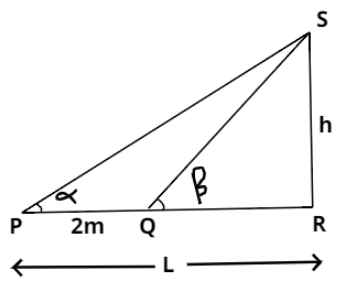
The angle of elevation of the top of a vertical tower from a point P on the horizontal ground was observed to be
(A)
Answer
525.6k+ views
Hint: Analyze the situation with a diagram. Use trigonometric ratios to find the distance of point P from the foot of the tower in both cases. And then compare both values to get the desired result.
Complete step-by-step answer:

Consider the above figure, let L be the initial distance of the foot of the tower from point P and h be the height of the tower.
As per the information given in the question,
From
Now, after moving 2 meters towards the tower we reach another point Q. Then the distance between the foot of the tower and point Q is
Now, comparing equation
Taking
Now we know that,
We know that,
Therefore, the height of the tower is
Note: We can use any of the trigonometric ratios to get the end results. But in this case, perpendicular and base are known for the given angles so it is convenient to use either
Complete step-by-step answer:

Consider the above figure, let L be the initial distance of the foot of the tower from point P and h be the height of the tower.
As per the information given in the question,
From
Now, after moving 2 meters towards the tower we reach another point Q. Then the distance between the foot of the tower and point Q is
Now, comparing equation
Taking
Now we know that,
We know that,
Therefore, the height of the tower is
Note: We can use any of the trigonometric ratios to get the end results. But in this case, perpendicular and base are known for the given angles so it is convenient to use either
Recently Updated Pages
Master Class 11 Economics: Engaging Questions & Answers for Success

Master Class 11 Business Studies: Engaging Questions & Answers for Success

Master Class 11 Accountancy: Engaging Questions & Answers for Success

Master Class 11 English: Engaging Questions & Answers for Success

Master Class 11 Computer Science: Engaging Questions & Answers for Success

Master Class 11 Maths: Engaging Questions & Answers for Success

Trending doubts
Which one is a true fish A Jellyfish B Starfish C Dogfish class 11 biology CBSE

State and prove Bernoullis theorem class 11 physics CBSE

1 ton equals to A 100 kg B 1000 kg C 10 kg D 10000 class 11 physics CBSE

In which part of the body the blood is purified oxygenation class 11 biology CBSE

One Metric ton is equal to kg A 10000 B 1000 C 100 class 11 physics CBSE

Difference Between Prokaryotic Cells and Eukaryotic Cells




